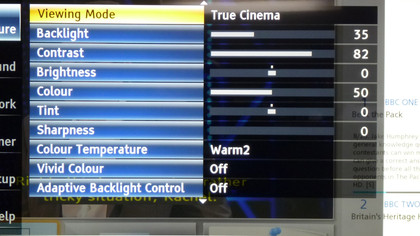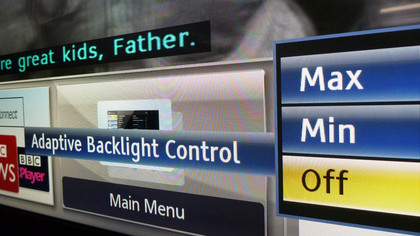Why you can trust TechRadar

As expected, Panasonic's use of a passive 3D screen means a solidly middle-ground performance - but nothing more. Our test disc, a Blu-ray version of Extremely Loud & Incredibly Close, revealed once again that Panasonic's True Cinema picture preset is a thing of wonder.
Straight out of the box it supplies a cutting-edge calibration that's 95 per cent as good as the long-winded real thing (which is possible thanks to an exhaustive colour menu). Detail is awesome, colours look natural, skin tones in particular, while there's a decent balance between light and dark, as demonstrated in a sequence of snow patches in Central Park. Granted, contrast and black levels are the main weakness; there's a blue-ish tinge to Central Park at night, with little shadow detailing visible. We also noticed some LED light leakage in the bottom right-hand corner of the screen.

When engaged, the Ambient Sensor introduces some plasma-like darkness to the image, but drains the luminosity of colour and the TV's bright peak whites fade, while the Adaptive Backlight Control lessens the shadow detail but does add some depth to black (although the blue tinge remains).
Upscaling is truly excellent - a real high-point - with a low-rent SD broadcast on BBC iPlayer, an ageing DVD and some digital video files from a USB stick all immaculately displayed. Bravo.
Sharpness is stable, with clean and tight horizontal and vertical lines for the most part, though one spiraling shot over a Manhattan zebra crossing did create some fleeting jagged edges.

Although it's becoming a standard feature in even mid-range televisions, the 100Hz panel immediately pays its way by helping to create smooth and sharp motion sequences. Fast camera pans don't introduce anything like the kind of distracting blur we used to find on LCD TVs, but it's always there to some degree - a rapid pan across the Brooklyn Bridge during Extremely Loud & Incredibly Close, for instance, reveals some minor judder.
The IFC mode, which inserts frames to remove judder, is best avoided for Blu-ray; it creates a fluid video-look but adds some nasty rips and tears around fast-moving objects, though less so for DVD.
Sign up for breaking news, reviews, opinion, top tech deals, and more.
The 3D performance is as expected, with clean, almost always crosstalk-free images (we did spot a few during Hugo), but with (very) visible horizontal lines. There's a slight drop in brightness from donning the 3D specs, and fast-moving bright objects in mixed-brightness sequences do cause artefacts not unlike those seen in the IFC mode. It is, however, hassle-free and offers a lot of depth - its use over active shutter is a wise decision, we'd judge.

Jamie is a freelance tech, travel and space journalist based in the UK. He’s been writing regularly for Techradar since it was launched in 2008 and also writes regularly for Forbes, The Telegraph, the South China Morning Post, Sky & Telescope and the Sky At Night magazine as well as other Future titles T3, Digital Camera World, All About Space and Space.com. He also edits two of his own websites, TravGear.com and WhenIsTheNextEclipse.com that reflect his obsession with travel gear and solar eclipse travel. He is the author of A Stargazing Program For Beginners (Springer, 2015),
